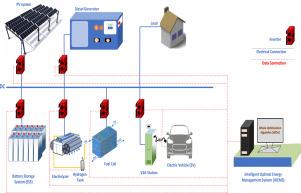Optimized resource allocation in autonomous microgrids through Dual-Level energy management using WOA and Game Theory
IF 7
2区 工程技术
Q1 ENERGY & FUELS
Sustainable Energy Technologies and Assessments
Pub Date : 2025-08-19
DOI:10.1016/j.seta.2025.104503
引用次数: 0
Abstract
Due to the intermittent nature of Renewable Energy Sources (RESs), advanced Energy Management Systems (EMS) are essential for Autonomous Microgrids (AMGs) to maintain power balance and stability. However, traditional EMS struggles with the dynamic dispatch of Vehicle-to-Grid (V2G)-enabled Electric Vehicle (EV) power flow, balancing Distributed Energy Resources (DERs), and addressing online computational delays. To tackle these challenges, this study proposes a novel dual-layer EMS framework that integrates the Whale Optimization Algorithm (WOA) and Game Theory (GT) for AMGs featuring Photovoltaic (PV) generation, battery storage, a fuel cell-electrolyzer system, a diesel generator, and V2G-enabled EVs. The simulation results demonstrate that WOA effectively manages EV charging and discharging, allowing V2G stations to supply up to 62% of the total load during RES fluctuations. The GT-based energy allocation further increases renewable penetration to 85%, ensuring fair distribution, low operational costs, and reliability. The framework maintains computational efficiency, outperforming traditional EMS in optimization speed for real-time operation. Key contributions include a WOA-based V2G scheduling model that stabilizes AMGs by leveraging EV flexibility, and a GT formulation for equitable and economical DER allocation. The proposed EMS offers a comprehensive solution for sustainable AMG management, combining stability, efficiency, and high renewable integration.

基于WOA和博弈论的自主微电网双能级能源管理优化资源配置
由于可再生能源(RESs)的间歇性,先进的能源管理系统(EMS)对于自治微电网(amg)保持电力平衡和稳定至关重要。然而,传统的EMS在车辆到电网(V2G)的电动汽车(EV)潮流的动态调度、平衡分布式能源(DERs)和解决在线计算延迟方面遇到了困难。为了应对这些挑战,本研究提出了一种新的双层EMS框架,该框架集成了鲸鱼优化算法(WOA)和博弈论(GT),用于具有光伏(PV)发电、电池存储、燃料电池-电解槽系统、柴油发电机和支持v2g的电动汽车的amg。仿真结果表明,WOA有效地管理了电动汽车的充放电,使V2G站在RES波动期间提供高达62%的总负荷。基于gts的能源分配进一步将可再生能源的渗透率提高到85%,确保了公平分配、低运营成本和可靠性。该框架保持了计算效率,在实时操作的优化速度上优于传统的EMS。主要贡献包括基于woa的V2G调度模型,该模型利用EV的灵活性来稳定amg,以及公平经济地分配DER的GT公式。提出的EMS为可持续的AMG管理提供了综合解决方案,结合了稳定性,效率和高可再生整合。
本文章由计算机程序翻译,如有差异,请以英文原文为准。
求助全文
约1分钟内获得全文
求助全文
来源期刊

Sustainable Energy Technologies and Assessments
Energy-Renewable Energy, Sustainability and the Environment
CiteScore
12.70
自引率
12.50%
发文量
1091
期刊介绍:
Encouraging a transition to a sustainable energy future is imperative for our world. Technologies that enable this shift in various sectors like transportation, heating, and power systems are of utmost importance. Sustainable Energy Technologies and Assessments welcomes papers focusing on a range of aspects and levels of technological advancements in energy generation and utilization. The aim is to reduce the negative environmental impact associated with energy production and consumption, spanning from laboratory experiments to real-world applications in the commercial sector.
 求助内容:
求助内容: 应助结果提醒方式:
应助结果提醒方式:


